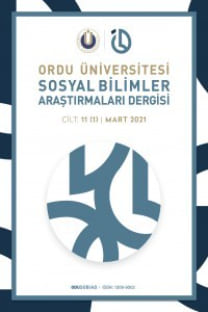Giritli Bektaşilerde Ziyaret Ritüeli: Horasanlı Ali Baba Tekkesi
Gönderilen makalelerde en az 500 kelime Türkçe yazılarda İngilizce, İngilizce yazılarda ise Türkçe özet (Abstract), en fazla beş anahtar kelime (hem İngilizce hem Türkçeleri) olmalıdır. Bir toplantıda tebliğ edilmiş ancak yayımlanmamış olan bildirilerde toplantının adı, tarihi ve yeri belirtilmelidir. The Pilgrimage Ritual at Cretan Bektashis: The Tekke of Horasanlı Ali Baba This study aims at revealing the pilgrimage rituals of the Bektashis having emigrated from Crete to Mersin. The most important visiting place for the Cretan Bektashis living in Turkey is the tekke of Horasanlı Ali Baba. Being currently situated in the place called ‘sultan’ or ‘tekke’at the district of Reşadiye in Tarsus, the grave of Horasanlı Ali Baba is regarded as a center of belief for all the Cretan Bektashis in Turkey. As a historical figure, Horasanlı Ali Baba is accepted to be among the colonizing Turkish dervishes besides his undeniable efforts towards the spread of Islam to the island of Crete. Horasanlı Ali Baba went to Crete in 1055 AH as having been appointed as the head of the band that Vahdeti Dede of Didymoteicho, the postnişin of Pir Evi, arranged for the Cretan expedition, and took part in Ottoman army during the conquests of Chania (Hanya), Heraklion(Kandiye) and Rethymno(Resmo). Having founded a small lodge in the village Voni (Dedeler) in 1057 AH, Horasanlı Ali Baba inaugurated a large lodge, also referred as the Horasanlı derhagı, in 1060 AH in Heraklion and proceeded the activities of irşad. He departed the earthly life in 1082 AH. Having been adopted to be the Bektashi dervish introducing Bektashi order into Crete, Horasanlı Ali Baba went on irshad at the dergah of Horasanlı till he passed away in 1082 AH. His relics were placed in a coffin by Cafer Sadık Bektaş Baba having been immigrated as another Cretan Bektashi into Turkey in 1924, and were buried in the tekke which is currently visited. The Cretan Bektashis make a vow to the tekke of Horasanlı Ali Baba for such reasons as getting rid of any illness, having children, avoiding accidents and calamities, expressing gratitude. It has been also observed that the Cretan Bektashis in the research field of us make vows to the tekke of Horasanlı Ali Baba at Nawruz, Hıdırellez, Aşura Day after Muharram fast and feast of sacrifice. It has been observed that the lodge of Horasanlı Ali Baba is visited not only by the immigrant Cretan Bektashis but also other Cretan Bektashis living in such cities as Antalya, Aydın, İzmir, Manisa, Ankara and Istanbul. The cults emerging with the visits of the lodge Horasanlı Ali Baba are ancestors cult and vow. Horasanlı Ali Baba is defined as God by the immigrant Cretan Bektashis. It has been concluded that Horasanlı Ali Baba is a sacred charismatic personality who supplies child to those without any children, and cures the diseased and protect from all the dangers. In other words, Horasanlı Ali Baba seems to be a heroic ancestor securing the community of immigrant Cretan Bektashi. The data of this study has been gathered from the villages of Hebilli of Mersin, İhsaniye of Tarsus and Turunçlu of Erzin with the attended observation and in-depth interviews by the means of qualitative research which has been conducted since March of 2015, especially in summer. The obtained data has been assessed. Key Words: Cretan Bektashis, Horasanlı Ali Baba, Pilgrimage ritual, Vow Anahtar kelimeler: Giritli Bektaşiler, Horasanlı Ali Baba, Ziyaret ritüeli, Adak
Anahtar Kelimeler:
Giritli Bektaşiler, Horasanlı Ali Baba, Ziyaret ritüeli, Adak
___
- A.MKT.MHM, Dosya No: 503, Gömlek No: 29
- A.MKT.MHM, Dosya No: 512, Gömlek No: 14, Tarih-21 L 1318
- Acıpayamlı, Orhan. (1974). Türkiye’de Doğumla İlgili Adet ve İnanmaların Etnolojik Etüdü. Ankara.
- BOA HAT Dosya No: 293 Gömlek No: 17474-B
- Altı, Aziz. (2018). “Balkanlarda Bektaşi Tekkeleri ve Bektaşilerin Devlet Erkânıyla İlişkileri (XVII-XVIII. Yüzyıl)”. Yayınlanmamış Doktora tezi, Erciyes Üniversitesi Sosyal Bilimler Enstitüsü. Kayseri.
- Arık, Durmuş. (2005). “Kırgızlarda Kurban Fenomeni”, AÜİFD XLVI, I, 157-174.
- Ata, Mehmet Reşat. (2009). "Girit-Kandiya Horasanlı Ali Baba Dergâhı Son Postnişini Halife Sadık Bektaş Baba", Türk Kültürü ve Hacı Bektaş Veli Dergisi 49, 157-174.
- DH.İD, Dosya No: 97-1, vesika No: 21, 25 CA 1329
- Emgili, Fahriye. (2006.)“Tarsus'ta Girit Göçmenleri (1897-1912)”, Ankara Üniversitesi DTCF Tarih Araştırmaları Dergisi 25/39, 189-197.
- Gökbel, Ahmet. (1998). Anadolu Varsaklarında İnanç ve Adetler. Ankara.
- Güngör, Harun. (1998). Türk Bodun Bilimi Araştırmaları. Kayseri.
- İnan, Abdulkadir. (1995). Tarihte ve Bugün Şamanizm. Ankara.
- K. 443 nolu yazma. İstanbul Büyükşehir Belediyesi Atatürk Kitaplığı
- Köprülü, O. F. (1980). “Usta-zâde Yunus Bey’in meçhul kalmış bir makalesi Bektaşiliğin Girid’de intişârı”. Güneydoğu Avrupa Araştırmaları Dergisi 8-9, 37-86.
- Lozan Barış Konferansı Tutanak ve Belgeler. 1973.
- Maden, Fahri. (2013). Bektaşi Tekkelerinin Kapatılması (1826) ve Bektaşiliğin Yasaklı Yılları. Ankara.
- Pamuksüzer, Ali. (2014). Tarsus’un Değerleri. Tarsus.
- Selçuk, Ali. (2004). “Tahtacıların Doğum ile ilgili İnanç ve Uygulamalarına Fenomenolojik bir Yaklaşım”. Türklük Bilimi Araştırmaları 16, 163-180.
- Selçuk, Hava. (2008). Şeriyye Sicillerine Göre Girit Sancağı ve Girit Seferi’ne katkısı(1645-1669). Kayseri.
- Selçuk, Hava. (2016). “Girit Müslümanları İçin Balkanlardan Yapılan Yardımlar”. SOBİDER 7, 16-26.
- Tukin, Cemal. (1996). “Girit”. DVİA 14, 85-93.
- ISSN: 1309-9302
- Yayın Aralığı: Yılda 3 Sayı
- Başlangıç: 2010
- Yayıncı: -
Sayıdaki Diğer Makaleler
Majid Majidi Filmlerinde Anlamın İnşacısı Olarak Doğa
"Sanatın Sonu" ve Andy Warhol'un Sanatı
Erol TAŞ, Sibel BAŞOĞLU, Jülide SARIGÖL, Banu TEPE, Hatice GÜLER
Giritli Bektaşilerde Ziyaret Ritüeli: Horasanlı Ali Baba Tekkesi
Use of Social Media as a Tool for Political Communication in the Field of Politics
Muhammed Doğukan BALÇIN, Melike YAVUZ TOPALOĞLU
